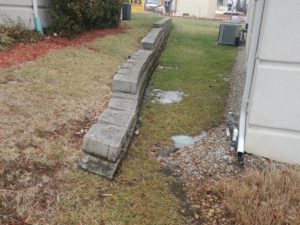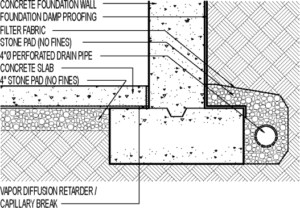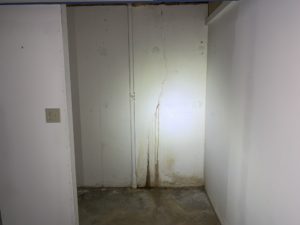Maintain proper drainage

A cost effective approach to basement waterproofing is to maintain with perimeter surface drainage conditions. The importance of proper drainage and landscaping (mature trees) around a foundation cannot be over emphasized. Poor drainage around the foundation is the most common cause of foundation problems and basement moisture problems. Drainage and moisture control around the home include proper ground slopes away from the foundation. It also includes keeping your gutters clean and the downspouts functional. Not doing so, allows the water from the roof to overflow the gutters. This water then runs along the foundation and in turn can cause basement seepage or foundation movement.
New Construction Basement Waterproofing
In new construction, cast-in-place concrete foundations are more resistant to water penetration than concrete block. Bituminous waterproofing should be used, at a minimum, to seal the outside of any foundation wall, however. An effective perimeter drain system should be installed to collect water from around the foundation and under the slab.

The National Association of Home Builder’s booklet on dry basements entitled, “Basement Water Leakage – Causes, Prevention, and Correction,” recommends perimeter drains on the inside and outside of the foundation. These drains should either flow downward to a gravity outlet (natural drainage) or to a sump where the water can be discharged with a sump pump.
A building built in a wet site should take advantage of additional waterproofing; a membrane system. One example of a membrane system consists of multiple layers of impervious material applied in a hot tar mopped system to the outside of the foundation. Special attention should be paid to the joint between the wall and the footing. The concrete floor and walls (whether block or concrete) should be reinforced to minimize cracking.
Existing Construction Basement Waterproofing
A water problem in an existing basement can only effectively be dealt with by:
- rewaterproo
 fing the outside of the foundation walls and/or
fing the outside of the foundation walls and/or - upgrading the exterior foundation drainage system
Both approaches require excavation around the outside of the foundation.
There are alternatives which will intercept the water using a channel-like system around the interior of the foundation wall to collect and guide the water into a sump and discharge it using a sump pump. These systems do not correct the water problem but they do control the water once it has entered the basement in a way that minimizes problems related to water entry. Such systems, while dealing more with the symptom than the cause, are typically less expensive because they can be accomplished from the inside.
Ultimately, when dealing with a basement water problem, the tried and true conventional methods working from the outside are still the most reliable.
Basement waterproofing and existing building, or rewaterproofing, the outside of a basement wall requires excavation to the full depth of the wall, careful cleaning of the wall surface and proper application of bituminous waterproofing. A multi-layered membrane system should be used if the surrounding water conditions are severe. At the same time, a perimeter drain system should be installed, similar to the recommendations noted above for a new foundation. If there are cracks in a wall, the cracks should be chipped out to form a V-groove along the length of the crack approximately one inch deep. The V-groove should then be sealed with a good quality epoxy or silicone caulking, filled with mortar and covered with bituminous waterproofing.
Epoxy injection
An effective, but sometimes expensive alternative, is epoxy injection into the crack. This can be done from the inside. The epoxy bonds with the concrete and creates a somewhat permanent seal against water penetration. The limitations to this system are cost and effectiveness, depending on the size of the crack. The smaller the crack, the less likely it is that full penetration injection is possible. However, before undertaking expensive excavation around the outside of a foundation, you may want to get proposals from local epoxy companies to compare the cost and potential effectiveness.
Basement water is controllable but there is no easy answer. Only the more complex and sometimes expensive approaches are truly reliable.
Peaceful Coexistence
Peaceful coexistence is sometimes an appropriate resolution to a basement water problem. While keeping water out of a basement may seem ideal, there are risks. Preventing water from entering an older stone or concrete block foundation can cause water to accumulate on the outside of the foundation walls increasing water pressure on the walls themselves. The result can and has been total failure of the foundation wall. Where the construction of the foundation wall is marginal or questionable, the better approach to water control is to permit the water to enter, collect it into an interior drainage system, guide it to a sump and pump it away.
Check out our Residential Services to learn more about how we can help!
